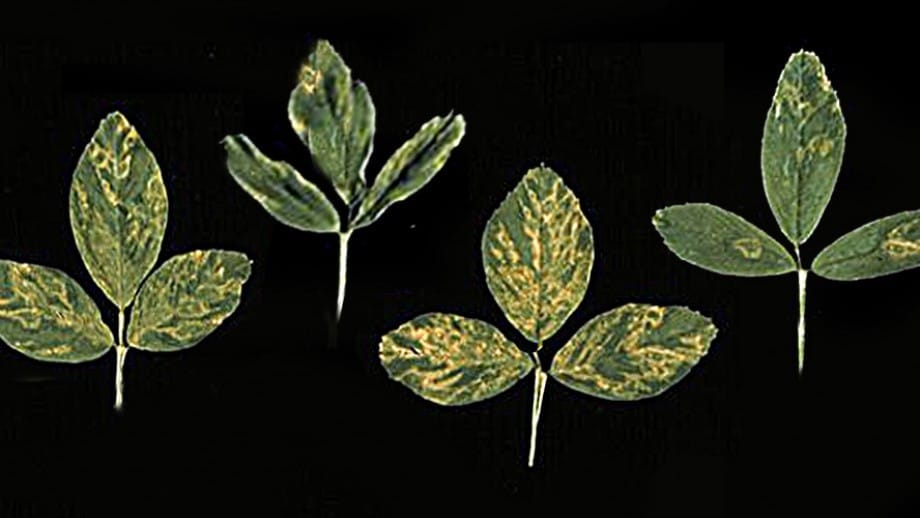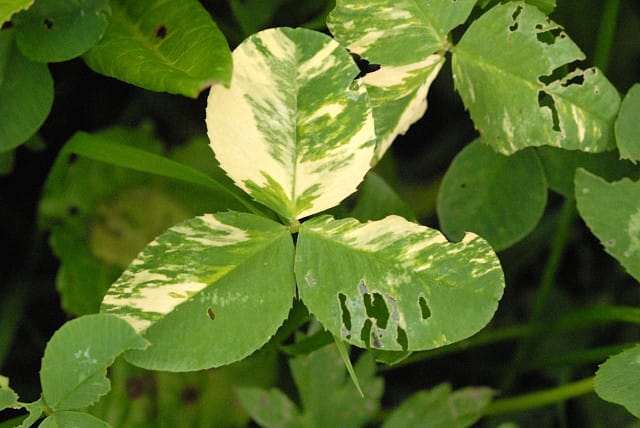Article Summary:
Plant infections and diseases can deal a huge blow to your pasture productivity and reduce profits. One such infection to watch out for is the Alfalfa mosaic virus (AMV) that has been spreading worldwide and infecting pasture legumes, pulses, and grasses. Preventing the transmission of AMV is the best management practice. Learn with us ways to protect your flourishing pasture.
Anything that hinders, modifies, or impairs a plant’s functions falls in the category of plant disease.
Diseased plants cannot grow to their full potential.
Plant diseases deal a detrimental blow to pasture productivity and foil management plans, leading to a financial disaster. Some plant diseases are more lethal than others. One to watch out for is Alfalfa Mosaic Virus (AMV).
This virus infects a wide variety of pasture grasses and ought to be controlled and managed.
Alfalfa mosaic virus has earned many names, also known as Lucerne mosaic virus, potato calico virus, etc. AMV was first discovered in the USA, and now it's a worldwide distributed virus bringing harm to various pasture plants.
AMV infects over 600 plant species worldwide and is a cause of major concern everywhere.
Today we discuss how to protect your flourishing pasture from AMV. We will take a look at factors that decide the severity of AMV infection in pasture legumes and pulses.
AMV causes a range of problems in pasture species, from necrosis to chlorosis, and blotches. We will discuss how the alfalfa mosaic virus transmits and the role played by its host plants.
Lastly, we will discuss control and prevention measurements farm management should adopt. Without further ado, let’s get started.

Alfalfa Mosaic Virus
Let’s start by taking a look at the alfalfa mosaic virus. Lucerne is the main source of alfalfa mosaic virus along with other temperate pulses like chickpeas, lentils, pasture legumes, and perennial weeds.
The vectors responsible for the transmission of the alfalfa mosaic virus are common amphids. It can also be transmitted by seeds and pollens of infected plants. Furthermore, parasitic vines are also responsible for virus transmission.
Altogether, these methods of transmission present a bleak picture and cause high levels of infections.
Factors controlling AMV symptoms
The severity and type of symptoms for plants infected by this virus depend on the following factors.
- The strain of the virus in infected plant
- Types of host
- Stage of growth at infection
- Environmental conditions
Common symptoms are bright yellow blotches, systemic necrosis, and stunted growth. Some plant species recover from the alfalfa mosaic virus at an early stage, while in others, there may be a reduction in seed size.
AMV Symptoms in pasture legumes and pulses
AMV infects various pasture legumes and pulses, which can lead to a reduction in pasture productivity. Well, we don’t want that, so let's look at some symptoms to identify this virus as early as possible.
- It causes shoot tip necrosis in chickpeas. Just like the name suggests, it's bad news for your pasture chickpeas. This shoot tip necrosis results in the death of the shoot tip.
- Faba beans display symptoms by developing chlorosis, necrosis, stunting of new shoots, leaf rolling, and ring-shaped blotches on leaves.
- Lupins display stunted growth. The tips of the leaves also become yellow.
- The leaves in lentils deform, twist, and display stunted growth and a necrotic tip.
- Lucerne displays mosaic, and the margins of leaves appear red. However, these symptoms may disappear in summer.
- New shoots of field peas develop chlorosis and necrosis. Pods of field peas either deform or fail to develop peas.
- Subterranean clover shows vein clearing and often plant stunting. The leaves may also develop chlorosis and necrosis.
Transmission of Alfalfa Mosaic Virus
Keep in mind, the symptoms displayed by plants infected with AMV are easily confused with nutrient deficiencies and herbicide damage. This dilemma makes it crucial to observe and identify the cause of viral symptoms.
One way is to understand how AMV transmits and who the hosts are.
Alfalfa mosaic virus survives in infected seeds and host plants. It cannot persist in stubble and soil. Aphids and dodders spread the virus from infected plants to healthy ones.
There are more than 5000 species of aphids capable of spreading the alfalfa mosaic virus, 20 such species are active in Australia.
Some common AMV vectors are:
- Blue-green aphid
- Cowpea aphid
- Foxglove aphid
- Ornate aphid
- Green peach aphid
- Spotted alfalfa aphid

Hosts of Alfalfa Mosaic Virus
The host plants of the alfalfa mosaic virus are not limited to the Fabaceae family. The host plants range from pulses to legumes, and even vegetable plants. Some common hosts are;
- Posture pulses; Faba beans, Chickpeas, Field peas, Lentils, Lupins, Narbon beans, Grass peas, Vetch, etc.
- Pasture legumes; Lucerne, Burr Medic, Annual medics, Clover species.
- It can also infect a range of vegetable crops.
The financial blow caused by AMV
AMV has dealt a huge financial blow to various farms. Pasture lucerne was recorded with a high infection rate of 50-98%. Similarly, a reduction in dry matter and loss of healthy seeds has its economic price for AMV infected pasture.
There may be less economic loss in terms of yield if plants recover quickly from the AMV.
Seed yield loss varies with host species and maybe more than 70-80%.
Prevention is the Best Farm Management Practice
Now that we know, the transmission process of the alfalfa mosaic virus happens via infected seeds, aphids and host plants.
Let’s look at some preventive measures.
- Ensure the seeds are healthy. Many companies provide AMV treated seeds that can prevent the infestation of AMV.
- Chemical control of aphids had not been an effective method for controlling the spread of AMV.
- Avoid growing pasture legumes and pulses adjacent to an infected pasture. This measure will minimize AMV transmission.
- Retain stubble on pasture because aphids are attracted to bare ground. This measure reduces the aphid landing rates and thus lowers the AMV spread.
- Early sowing to acquire canopy closure shades out AMV infected week plants and thus helps reduce the spread.
- Farms that retain their seed bank should plant only healthy seeds. Farms can benefit from commercial seed testing as well.
Preventing the spread of AMV is crucial for your flourishing pasture. AMV has various strains, therefore it’s a little tricky to control. Furthermore, the spread of AMV depends on temperature and light. AMV infection slows down at lower temperatures.
Similarly, the absence of lights slows down AMV spread.
The best strategy to prevent the spread is through seed testing to ensure you grow healthy seeds free from AMV or other viruses.
This brings us to the end of the article. Until we meet again, Happy Farming!
- The Dedicated Team of Pasture.io, 2022-02-02